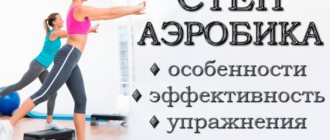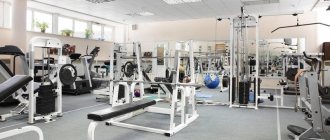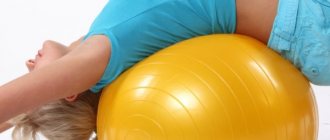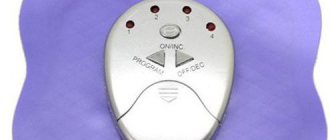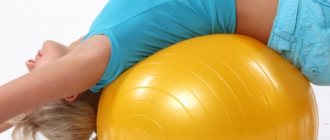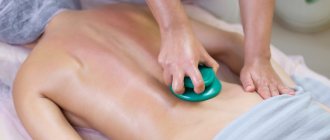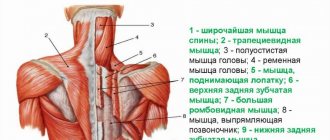Features of fitball
The obvious “advantage” of a fitball is its ease of use - a person with any physical fitness can start exercising with the ball. Exercises on this apparatus are recognized as gentle on the spine and lower back, so people with osteochondrosis and other back diseases can exercise on it. Exercises on this fitball are considered therapeutic exercises.
The round shape requires constant concentration and balance. The body receives sufficient stress on all muscle groups, especially the buttocks, thighs and abs. Therefore, exercises using a gymnastic ball promote good blood circulation and burning of fat deposits.
Most often, a fitball is made of dense and flexible materials - latex or PVC. Therefore, the ball can withstand a load weighing up to 300 kilograms. Choose a ball with an ABS system, because in case of excessive weight load or an accidental puncture, the gymnastic ball will not burst with a loud, frightening sound. The fitball will simply deflate, and you will have time to get off it.
Benefits of fitball
A Pilates ball will help:
Improve posture
When you sit on a fitball, you constantly put pressure on your back, which not only improves your posture, but also reduces the risk of pain in the back and cervical spine. “The effort we make to maintain balance forces us to remain upright and avoid strain on our backs. In addition, a fitball helps you wean yourself from the bad habit of sitting with your legs crossed, which negatively affects your posture,” explains the expert.
View on Instagram
If you are used to sitting on a chair in the wrong positions, you may initially feel uncomfortable sitting on the ball - you will probably feel pain in your back. Don't worry, the specialist explains that "this is completely normal and even not bad, since you are straining previously unused spinal muscles."
View on Instagram
Strengthen muscles
Of course, a fitball does not replace a full workout, but when you sit on the ball, the muscles of your back, legs, buttocks and abdomen work and are tense.
Improve blood circulation
While you sit on the ball, your body is in an unstable position, which improves blood circulation.
View on Instagram
Reduce cellulite
Sitting on a fitball affects the work of the gluteus maximus muscle and helps fight cellulite.
Pump up your abs
To maintain an even posture and maintain balance on the ball, we tense our legs, and at the same time our abdominal muscles. So, while solving work issues, you simultaneously pump up your abs.
View on Instagram
Improve your sense of balance
Of course, the ball will not stay in one place all the time, and in order not to fall, you will have to constantly keep your balance and improve your sense of balance.
Improve concentration
Thanks to the fact that, while sitting on a fitball, you constantly maintain your balance, your brain function is activated. At this time, concentration and attention improve, which will undoubtedly have a positive effect on the quality of the work you perform.
View on Instagram
Who needs it and why?
Sedentary work and lack of free time for physical activity inevitably affect your back health. The spine experiences enormous stress every day. If you sit at a computer or papers, then your body is tense and motionless for a long time. Or the opposite situation: excessive physical activity and, as a result, muscle strain. In both cases, the body needs to relax. Therefore, a logical and necessary end to the working day will be a special set of exercises for the spine using a fitball. After classes, you will feel lightness throughout your body, your back will stop “aching” and hurting.
For people with problems with the spine and joints, a fitball can be a godsend. The Internet is full of video tutorials and special practical recommendations for exercising on a fitball, which help relieve the back and regulate the functioning of the musculoskeletal system. This set of exercises is simple and easy to perform.
Those who are interested in improving their body at home will certainly experience the effectiveness of a gymnastic ball. There is no need to buy an expensive exercise machine: a fitball will successfully replace it. The sphere is unstable and balancing on the ball forces more muscles to work even during standard activities. Maintaining balance and performing the exercise at the same time is the secret to the effectiveness of exercise on a fitball. You can just sit on it, and this will already be a physical activity.
Expectant mothers will definitely appreciate the benefits of a fitball. Constant load on the lower back during pregnancy, preparing the body for childbirth and the birth of a baby, relieving pain during contractions - a gymnastic ball can solve these problems. Many doctors advise doing gymnastics for pregnant women using a fitball and preparing the body for labor. Also, you can always take the ball with you during childbirth and use it to relieve the pain from contractions.
A fitball can also be useful for a young mother to get her body back into shape after childbirth. You can exercise on a fitball at a convenient time, being in close proximity to your baby. There is no need to find time, find funds and gather strength to visit the gym - you can remain in control and exercise on a gymnastic ball at any time.
Such gymnastic equipment is also intended for recreational and therapeutic gymnastics for children. For newborn children, exercising on the ball will help get rid of hypertension and will have a beneficial effect on the mental and physical development of the baby. For children over 1 year old, the simulator helps develop coordination and the vestibular system, improves tone and strengthens muscles. For children, fitball will become a source of positive emotions.
Press crunch
This exercise on a fitball is perfect for those who experience back discomfort when performing abdominal crunches on the floor or bench. Also, with the help of a fitball, you can ideally feel the abdominal muscles, understand and consolidate the correct movement technique, which you will use in the future in other abdominal movements.
- Sit down on the exercise ball, and then a few steps forward, place it behind your back, closer to your lower back.
- Then, in reverse steps, roll the exercise ball so that you are completely lying on your back on it.
- Place your elbows bent near your ears.
- As you exhale, twist, lifting your body up.
- As you inhale, return to the starting position, fully stretched.
Perform 4 sets of 15 reps.
As you lift your torso up, focus on bringing the bottom edge of your ribs toward your pelvis—this is exactly how your abs work, as they attach just above the bottom edge of your ribs on one side and near your iliacus bones on the other.
At the top point of the positive phase, try to squeeze your abdominal muscles as much as possible, making an additional forced exhalation.
During the negative phase, always straighten your body completely, moving it as far back as possible, while trying to move the lower edge of the ribs as far as possible from the iliac region, thereby completely relaxing the abdominal muscles.
How to choose a ball
A gymnastic ball is selected according to height and weight. If the size of the apparatus is too large, it will not allow your legs to stand on the floor with your full feet - this increases the risk of falling and makes the exercises less effective. But a ninety-degree angle in a sitting position between the body and the thigh, lower leg and foot indicates that the specific size of the projectile is suitable for a given person.
The practice of choosing a gymnastic ball by height involves large balls, with a diameter of 75 cm, for people from 180 cm. A diameter of 65 cm is suitable for people of average height, from 170 cm. A small height from 150 to 170 cm goes well with a sword diameter of 55 cm.
For children up to 150 cm tall, the smallest fitballs are ideal - 45 cm in diameter. The choice of a ball for a child is also based on additional safety systems. Handles in the form of horns will help the baby keep his body on the ball. Spiked balls on the surface of the fitball prevent the product from sliding on the floor and have a massage effect.
Strengthen muscles, increase body flexibility, relieve fatigue - this projectile is successfully used in all directions. All you have to do is choose a fitball and start exercising on it. Remember, by doing gymnastics on such a ball, you strengthen not only your muscles, but also your health!
Hyperextension on a fitball
The exercise is also suitable for those who, for whatever reason, experience discomfort when performing this movement with classic equipment or on the floor. For greater efficiency, you can use a wall as a footrest.
- Walk with your back to the wall, placing the ball in front of you.
- Lie on your stomach on the ball, with your knees on the floor and your feet against the wall.
- Bring your arms bent at the elbows to the ear area.
- As you exhale, lift your body as high as possible.
- As you inhale, return to the starting position.
Perform 4 sets of 15 reps.
At the end of the negative phase, try to stretch and relax your lower back as much as possible.
Fitball: training with a ball
December 2, 2009
For those who lead a predominantly sedentary lifestyle, exercise with a popular gymnastic equipment - a fitball - is well suited.
For those who lead a predominantly sedentary lifestyle, exercise with a popular gymnastic equipment - a fitball
.
This is a large inflatable ball, with a diameter of 55 to 75 centimeters, which is usually used for aerobics. Exercises with a fitball allow you to develop coordination of movements and improve posture
.
In addition, maintaining balance on an elastic ball gives an even and good load on all muscle groups.
. But at the same time, exercising on a fitball is quite gentle on the joints of the lower extremities. Therefore, with the help of a large ball, those with joint problems and excess weight can exercise. Or those who are just starting to improve their physical fitness.
Marina Makarova, head of the exercise therapy department of the Center for Restorative Medicine and Rehabilitation of the Medical and Rehabilitation Center of the Ministry of Health and Social Development of the Russian Federation, talks about how to improve coordination of movements with the help of a fitball.
“Unfortunately, most people lead a clerical life. Therefore, in order for them to have precision and dexterity of movements, as well as a beautiful gait, posture and not to completely deteriorate their handwriting, it is necessary to regularly perform coordination exercises
movements,” says Makarova.
How to choose a fitball
A fitness ball must be made of a homogeneous and dense material
, with a certified load of up to 300 kilograms.
To choose a ball that suits your height
, you need to sit on it and put your feet on the floor.
In this case, the flexion angles of the hip, knee and ankle joints should be 90 degrees
. For those whose height is 160-170 cm, a ball with a diameter of 65 centimeters is suitable. For taller people - 75-80 centimeters. And children and petite women should choose 55-60 cm fitballs.
The simplest exercise for developing coordination is swinging on a ball.
. Performed while sitting, in the forward-backward and left-right directions. Swinging can be combined with bouncing, because the elastic fitball allows you to do this. The exercise is quite easy to look at, but almost all the muscles of the back, legs and neck are involved to maintain balance.
To continue training your coordination, extend your legs slightly forward and spread them wider. And spread your arms to the sides at shoulder level. Bouncing lightly on the ball, bend
alternately both hands to the shoulders and again spread to the sides. The load can be increased by placing emphasis on one leg in turn and slightly lifting the other.
If you combine the movements with body turns in different directions, staying on the ball will become very difficult, and almost all the muscles of the torso and legs will begin to work.
The next exercise is swinging on a fitball and rolling it a little on the floor. Moreover, the hands rest on the ball behind the buttocks, and when moving, the legs alternately rise up parallel to the floor. You can increase the load by changing the raised legs and bouncing on the ball.
This is an exercise to “pull your arms and legs together”
. Place your hands on your belt and, bouncing on the fitball, lift your right leg up and move your left arm to the side. Then vice versa, so that the limbs located diagonally work.
The vibration from the spring ball is good for the spine
, allowing for improved blood supply to its discs and adjacent muscles. The same vibration allows you to work out the small muscles of the spinal column well.
Waist flexibility will allow you to develop body rotations. While jumping on the fitball, move your hand, placed on your belt, behind your back, lifting it to shoulder level. At the same time, rotate your upper body behind it.
Restore coordination of movements for tired hands
You can also do it without getting up from the fitball. The arms are extended forward, palms down. After this, at the maximum possible pace, the hands are alternately clenched into a fist and unclenched.
Complicate the task by adding rotations around the horizontal axis to the movement of the hand so that the open hand is palm up and the clenched hand is down. After this exercise, it is good to pull your arms forward in front of your chest, clasping them together.
To improve the coordination of hand movements, the “steps” exercise is suitable, which can also be done while sitting on a fitball. Hands are placed on the belt, after which, slightly springing on the ball, you need to sequentially place one hand, followed by the second hand, on your shoulders, and then lift them vertically up.
After completing the exercises, relax the worked muscles. This can be done without getting up from the fitball. Stretch your arms out to the sides and take a deep breath. As you exhale, bend down and clasp your legs with your hands.
Illustration: Chris Dlugosz
Tags:
- Home workouts
To leave a comment you must be an authorized user
Is it possible to exercise on a fitball during pregnancy?
What is fitball? This is not just a big bouncy ball and fashionable fun. Fitball is a universal sports machine that can be used by all family members, young and old, without leaving home. Exercises with a ball (including on a ball) are also recommended for pregnant women at any stage of pregnancy. After all, fitball exercises are safe and effective, they force all muscle groups to work, and primarily the muscles of the back, perineum, and abdominals, help to better coordinate your movements and control your body - all this will be especially useful for the expectant mother.
Attention!
During pregnancy, there may be individual contraindications for exercising with a fitball. Therefore, before starting to use the ball, women should consult their doctor.



